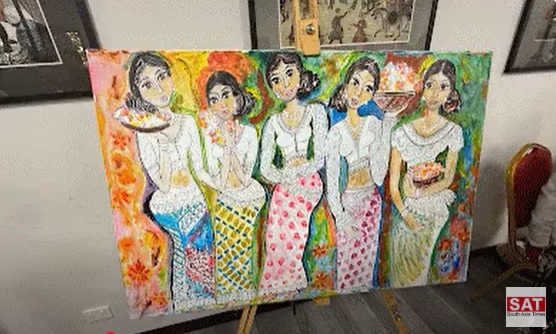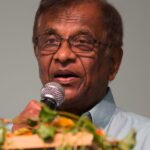
Diasporic Literature and Cultural Barriers – Lionel Bopage
- Sujeewa Senerath
- April 1, 2025
- News, Political
- lionel bopage, sinhala diaspora, tamil diaspora
- 0 Comments
Ayubowan, Vanakkam, Assalamu alaikum and Greetings to all.
This discussion takes place in the traditional lands of the First Australians – the Wurundjeri People of the Kulin Nation – the Traditional Custodians of this land. We pay our respects to their Elders past, present, and emerging, and the Elders of other communities.
Ceylonese immigrants began arriving in Australia in the late 19th century due to labour shortages in Queensland. Dr. Wickrema Weerasooriya has highlighted early arrivals. Professor Michael Roberts has cited a 2019 article by Thiru Arumugam in this regard. Many of these Ceylonese immigrants were skilled tradespeople escaping economic hardship. Names such as Appos and Appus are still found in Queensland, descendants from those immigrants surviving to this day. Since the 1970s, political unrest prompted numerous Sinhalese, Tamils, and Muslims to migrate to Australia. Sri Lankan asylum seekers often face deportation due to the different socio-economic and political circumstances that prevail in Australia today.
Diaspora literature, also known as Expatriate or Diasporic Literature, encompasses works by authors living outside their native country who reflect on their native culture and identity and their dislocation or migration experiences. These writers address themes of loss and alienation, drawing from their personal experiences and navigating cultural tensions between their heritage and current environment. This genre explores migration, cultural identity, and belonging, offering unique perspectives on global history, colonialism, and human emotions and displacement.
While I was behind bars for the 1971 April Uprising, I had the opportunity to read some writings by the likes of Tariq Ali, Edward Said and Vidiadhar Naipaul. Tariq Ali is a Pakistani born British political activist, writer, journalist, historian, filmmaker, and public intellectual. Edward Said was a Palestinian American intellectual and scholar, known for his work on postcolonial theory and Orientalism that critiques Western representations of the East. V.S. Naipaul was a Trinidadian British writer known for his novels, essays, and travelogues that explore themes of identity, colonialism, and postcolonialism. His work often reflects the complexities of cultural dislocation and the diasporic experience. What I read of them, had more to do with politics, not much to do with their literary work.
Later on, I came to know of many writers engaged in diasporic politics and matters relating to cultural identity. There are writers from various diasporic communities, for example, African, Latin American, Asian, and Middle Eastern descent. They provided a broader understanding of diasporic political experiences and perspectives. Most of those writings challenge Eurocentric perspectives offering alternative ones challenging dominant narratives and highlighting the experiences of marginalized communities.
Diasporic Indian writers reflect on diverse lived experiences shaped by their geographic and societal location, influencing how they define their Indian identity. Similarly, many Sri Lankan Australians document the historical experiences of their communities, preserving cultural memory and promoting a deeper understanding of the past. In Australia, notable contributors include individuals such as Jagath Edirisinghe, comrade Muruga Poopathy, Dr. Noel Nadesan, Shankari Chandran, Prof. Chandani Lokuge, Swarnakanthi Dharmawardena (née Rajapakse), Malan Bandara Kapuwatta, and Prof. Yasmine Gooneratne, whose poem “Big Match 1983” describes the 1983 Black July riots in Sri Lanka. Other distinguished diasporic writers include Michael Ondaatje (a Sri Lankan Canadian), Shehan Karunatilaka (the author of ‘The Seven Moons of Maali Almeida’), Anuk Arudpragasam, Christopher Ondaatje, Romesh Gunesekera, and Shyam Selvadurai. My apologies for any names I have missed here.
An anthology of Sri Lankan and diasporic poetry, edited by Vidyan Ravinthiran, Seni Seneviratne, and Shash Trevett, features over one hundred poets who wrote in English or had their works translated into English from Sinhala and Tamil. This anthology highlights a long-neglected national literature and reshapes our understanding of the poetics of migration and atrocity. It includes poems about love, art, and nature, as well as those exploring critical events such as the JVP insurrections in 1971 and 1988-89, the 2004 tsunami and its aftermath, incidents affecting Muslim communities, and the civil war. The poetry examines the country’s troubled past and underscores the importance of remembering various life experiences, from colonial practices to conflict-driven history of the country.
Indian diasporic writers explore themes of identity, culture, and social issues through various genres. Notable authors include Jhumpa Lahiri, Salman Rushdie, Arundhati Roy, and Vikram Seth. Their works foster empathy and cultural understanding, reflecting on the complexities of Indian society. Sri Lankan authors like Martin Wickramasinghe, Bengali authors like Rabindranath Tagore, and Indo-Fijian writers address topics such as colonization and cultural displacement.
Diaspora literature highlights migration challenges, identity transformations, and the psychological impact of cultural shocks. It reveals how cultural identities evolve in multicultural contexts and the effects of economic globalization and social integration on cultural dynamics. Ultimately, diaspora literature has significantly influenced the international literary landscape, expanding and redefining national and global literary norms by introducing diverse voices and perspectives.
Asian literature has gained visibility and recognition, challenging Western dominance. This rise highlights Asia’s cultural diversity and historical context, with authors exploring themes like identity, migration, history, and memory. Previously hindered by language barriers and Eurocentric preferences, globalization has expanded its reach. Publishers also seek new voices from Asia and the diaspora, investing in translation and promotion.
Digital platforms and self-publishing offer opportunities for Asian authors to connect with global audiences, contributing to a diverse literary landscape. This shift reflects a greater cultural exchange and inclusivity. Readers are drawn to narratives reflecting global complexity, making Asian literature a dynamic force in the literary canon. Stories from Asia enrich our understanding and challenge the boundaries of literature.
With the Asian diaspora, particularly, Sri Lankan diaspora, the deficiency is that they concentrate on their own communities as their audience, as the market for their literary work. Only a few have been able to break through to the international arena, simply because their focus is on satisfying their own native customer base. Many Sinhala writers write to their Sinhala audiences, and many Tamil writers appear to do the same. And many Indian and other Asian writers too. In order to reach the international literary market, the narratives of the diasporic writers need to focus on catering to the needs of the international market and attracting that market.
This is not something that our diasporic writers are unable to do. They have the skills, capabilities, and the professionalism to do that. I believe what we lack is the will and commitment to do so. My message to our diasporic literariat is that they should have the courage to overcome those barriers and commit themselves to reach the international arena of literature.
I wish you all the best.
Thank you.

(A Speech I delivered at “Transmitting Culture in the Digital Age”, the Books, Art and Photo Exhibition organised by Australia South Asia Society, during the South Asia Arts & Literature Festival held in Victoria, Australia on March 23, 2025.)

